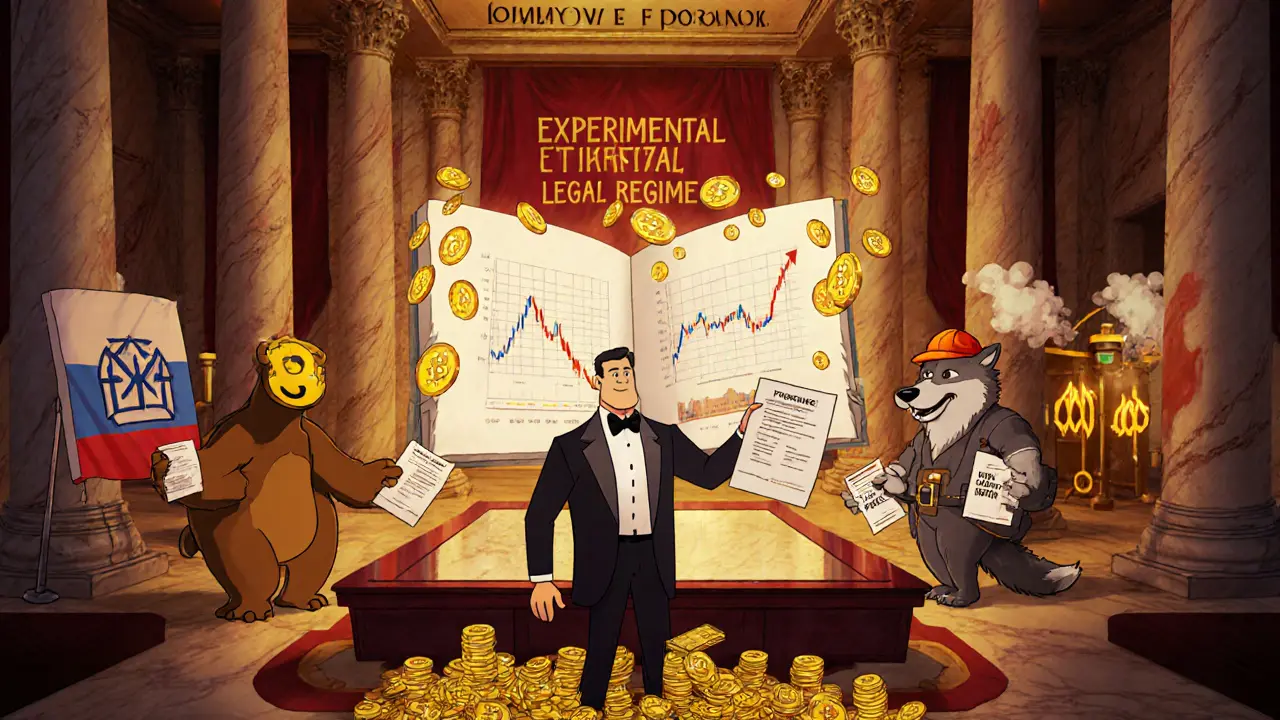Crypto Regulation in Russia: Rules, Restrictions, and Investor Impact

May, 24 2025
ELR Qualification Calculator
Calculate Your ELR Eligibility
Check if you meet the Russian Experimental Legal Regime thresholds for legal crypto trading.
Under Russia's ELR, individuals must either:
- Hold securities and deposits worth at least 100 million rubles (≈ $1.2 million)
- Earn an annual income of 50 million rubles (≈ $600,000) in the previous year
Your eligibility status will appear here after calculation.
Important Notes
This tool only checks if you meet the financial thresholds for ELR participation. Additional requirements include:
- Compliance with AML/KYC regulations
- Registration with the Bank of Russia
- Adherence to reporting obligations
What the current Russian framework actually looks like
Russia’s approach to digital assets feels like a tug‑of‑war between two worlds. On one side, the state wants to keep a tight grip on how crypto touches the domestic economy. On the other, it recognises the strategic advantage of using crypto for international trade and mining. The result is a hybrid system that lets a tiny elite trade and hedge, bans crypto as a payment method for everyday purchases, and pushes mining as a national priority.
Cryptocurrency Regulation in Russia is a legal framework that balances permissive ownership with strict usage limits. It emerged from years of debate between the Finance Ministry and the Central Bank, culminating in a July 2020 law that legalized crypto transactions but prohibited their use for domestic payments. The enforcement started in January 2021, creating a two‑tiered market that still shapes everyday Russian finance today.
If you’re wondering whether you can buy, sell, or use crypto in Russia, the short answer is: you can own and trade it if you meet strict investor criteria, you cannot spend it locally, and you can use it for cross‑border deals under a narrow set of rules.
The July 2020 law - the cornerstone of today’s rules
The law that launched the current regime did three things:
- Legalised ownership of crypto‑assets, allowing Russian citizens and legal entities to hold them.
- Imposed a ban on using cryptocurrencies for domestic payments, meaning you cannot pay for groceries, utilities, or salaries with Bitcoin, Ether, or any other token.
- Created reporting obligations for anyone dealing with crypto, including mandatory AML (Anti‑Money‑Laundering) and KYC (Know‑Your‑Customer) checks.
The law also gave the government a back‑door to tighten rules later, which it did with the Experimental Legal Regime introduced in 2025.
Experimental Legal Regime (ELR) - a three‑year sandbox for the elite
Experimental Legal Regime is a temporary three‑year framework launched in March 2025 by the Bank of Russia. It is designed for “highly qualified” investors who can meet hefty financial thresholds.
To qualify, a private individual must either:
- Hold securities and deposits worth at least 100 million rubles (≈ $1.2 million), or
- Earn an annual income of 50 million rubles (≈ $600 000) in the previous year.
Legal entities such as banks, investment funds, or broker‑dealers need to be licensed by the Bank of Russia and demonstrate robust risk‑management systems.
Once inside the ELR, participants can trade crypto spot, futures, and options on authorised Russian exchanges. In the first month after the regime opened, Sberbank and the Moscow Exchange together facilitated $16 million in Bitcoin futures contracts.
Who can actually access crypto markets?
The qualification thresholds mean that only a tiny fraction of the Russian population can legally trade crypto. Estimates put the number of qualified investors at under 0.5 % of adults. The rest of the market - which holds more than $25 billion in crypto assets - operates on foreign platforms, often using VPNs to bypass local restrictions.
There is an ongoing debate in the Finance Ministry about lowering these thresholds. Director Alexey Yakovlev has hinted at a possible revision, but any change will need the Central Bank’s green light.

What activities are allowed - and what’s still off‑limits?
Under the current rules, the following are permitted:
- Ownership of crypto‑assets for qualified investors.
- Trading of spot and derivative products on authorised Russian exchanges within the ELR.
- Mining operations that are registered and taxed.
- Use of crypto for international trade settlements - a 2024 amendment opened this narrow window.
- Holding and transacting with the state‑backed Digital Ruble pilot, which is separate from private crypto but part of the broader digital‑asset strategy.
What remains prohibited:
- Any crypto payment for goods or services within Russia.
- Use of domestic banking infrastructure for crypto purchases, except through ELR‑approved channels.
- Investment by regular banks in crypto‑assets outside the ELR scope.
Compliance heavy‑handed: AML, KYC and reporting
The Bank of Russia has built a comprehensive compliance regime aimed at preventing illicit finance. Key pillars include:
- AML monitoring: Financial institutions must flag and report suspicious crypto‑related transactions, with a special focus on peer‑to‑peer trades that skirt the ELR.
- KYC verification: All ELR participants undergo rigorous identity checks, source‑of‑funds verification, and periodic reporting to tax authorities.
- Mandatory exchange of transaction data between the Federal Tax Service and the Central Bank to create a real‑time audit trail.
Non‑compliant actors face fines up to 5 % of their annual turnover and potential criminal charges.
Mining - the only fully embraced crypto activity
The Russian government sees mining as a strategic asset that leverages its abundant, low‑cost energy. In 2023, President Putin issued a decree encouraging regions with surplus electricity to register mining enterprises. The result is a fast‑growing registry of licensed miners, many of which are now being nudged to repurpose their hardware for AI workloads - a move championed by Boris Titov, the President’s business development aide.
Mining revenue is taxed at a flat rate, and companies must report hash‑rate, power consumption, and earnings to the Ministry of Energy. This transparent framework contrasts sharply with the opacity surrounding private trading.
Crypto in international trade - a sanction‑busting tool
Sanctions have forced Russian exporters to look for alternatives to the SWIFT system. Crypto settlements provide a fast, borderless method to receive payment. In the first half of 2025, it’s estimated that Russian firms settled roughly 1 trillion rubles (≈ $12 billion) in trade using crypto. Boris Titov has framed this as a step toward an “alternative international payment system” that could pair the Digital Ruble with private tokens.
However, this exception is tightly regulated: only companies with a licensing certificate from the Ministry of Economic Development can use crypto for export invoices, and every transaction must be reported to the Central Bank.

Future outlook - will the regime open up?
The ELR runs until 2028. The Bank of Russia has repeatedly said the sandbox is a testing ground for permanent legislation. If the experiments prove that qualified investors can trade safely, we might see a gradual easing of thresholds. Alexey Yakovlev’s public comments suggest a willingness to consider a lower entry bar, but the Central Bank remains cautious, warning that too‑broad access could expose ordinary Russians to volatility and fraud.
Potential developments to watch:
- Lower qualification thresholds - could double or triple the pool of legal traders.
- Expansion of crypto derivatives - the Bank plans to let investment funds and asset managers join the market by 2026.
- Greater integration of the Digital Ruble with cross‑border crypto pipelines, possibly creating a hybrid settlement system.
- Enhanced mining incentives - tax breaks for regions that link mining rigs to AI compute clusters.
Until any of these shifts happen, the practical rule of thumb remains: if you’re not a high‑net‑worth investor or a licensed institution, you’ll stay on the unofficial side of the market.
Quick comparison: Domestic vs International crypto usage in Russia
| Aspect | Domestic (within Russia) | International (cross‑border) |
|---|---|---|
| Legal status | Allowed for qualified investors only; payments banned | Permitted for licensed exporters and importers |
| Access requirement | ELR qualification (≥ 100 m RUB assets or ≥ 50 m RUB income) | Company licensing from Ministry of Economic Development |
| Typical participants | Sberbank, Moscow Exchange, high‑net‑worth individuals | Energy producers, commodities exporters, large corporates |
| Regulatory oversight | Bank of Russia AML/KYC, tax reporting | Central Bank reporting, customs monitoring |
| Tax treatment | Capital gains tax on crypto sales | Revenue recognized in rubles; crypto considered settlement medium |
Bottom line for investors and businesses
If you’re a wealthy Russian looking to dip a toe into crypto, the ELR gives you a legal runway but comes with a steep entry bar and heavy reporting. If you run a business that exports goods, you can legally settle part of your invoicing with crypto, but you must register and file detailed transaction reports. For the average citizen, the safest route is still to stay out of crypto payments domestically and to use foreign exchanges at your own risk.
Frequently Asked Questions
Can I buy Bitcoin in Russia as an ordinary citizen?
Directly through a Russian‑licensed exchange, no-only qualified investors who meet the ELR thresholds can trade. Most people use foreign platforms, which technically operates in a legal gray area.
Is it legal to use crypto for paying bills or salaries?
No. The 2020 law explicitly bans using cryptocurrencies for any domestic payment, including utilities, retail purchases, or payroll.
What are the qualification thresholds for the Experimental Legal Regime?
Individuals need either 100 million rubles (≈ $1.2 million) in securities/deposits or a previous‑year income of 50 million rubles (≈ $600 000). Companies must hold a banking or brokerage licence from the Bank of Russia.
Can Russian exporters settle invoices with Bitcoin?
Yes, but only if they have a specific licence from the Ministry of Economic Development. Every transaction must be reported to the Central Bank.
Will the ban on domestic crypto payments stay forever?
There are no current plans to lift it. The government sees the ban as a way to protect consumers and maintain monetary sovereignty, while exploring other digital‑currency tools like the Digital Ruble.
How does crypto mining fit into Russia’s economic strategy?
Mining is fully legal and taxed. The state encourages it to monetize excess energy and to build computational capacity for future AI projects.
What might change after the ELR expires in 2028?
If the sandbox proves stable, lawmakers could codify a permanent regime with possibly lower thresholds and broader product offerings. Until then, the three‑year trial remains the only legal pathway for crypto trading.